Advertisement
If you have a new account but are having problems posting or verifying your account, please email us on hello@boards.ie for help. Thanks :)
Hello all! Please ensure that you are posting a new thread or question in the appropriate forum. The Feedback forum is overwhelmed with questions that are having to be moved elsewhere. If you need help to verify your account contact hello@boards.ie
Hi all! We have been experiencing an issue on site where threads have been missing the latest postings. The platform host Vanilla are working on this issue. A workaround that has been used by some is to navigate back from 1 to 10+ pages to re-sync the thread and this will then show the latest posts. Thanks, Mike.
Hi there,
There is an issue with role permissions that is being worked on at the moment.
If you are having trouble with access or permissions on regional forums please post here to get access: https://www.boards.ie/discussion/2058365403/you-do-not-have-permission-for-that#latest
There is an issue with role permissions that is being worked on at the moment.
If you are having trouble with access or permissions on regional forums please post here to get access: https://www.boards.ie/discussion/2058365403/you-do-not-have-permission-for-that#latest
Famous Irish Graves -They are dead but where are they buried.
Comments
-
Just to be clear, what is the criteria for a persons grave to be shown here? I have a few in mind, such as Wolfe Tone....
There are no hard and fast criteria -but this thread is for quirky and forgotten people & the footnotes.A bit more anthropological history if you like.It was a spinoff of looking for Mr Charlotte Bronte.
I have another thread on executions here
http://www.boards.ie/vbulletin/showthread.php?t=2055944797
Matthew Tone - Theobalds brother would be a fit as would his wife or son as would Thomas Emmet brother of Robert graves be here.
The Parkeeper in Stephens Green in 1916 -tea with Countess Markiewicz during the Rising & saved his ducks - who was he ??
The thing is that it is something that someone else will get a kick out of or it is something of interest.
I suppose its for people who may not merit a thread in their own right but as a genre do.0 -
George Charles Bingham aka the 3rd Earl of Lucan of the Charge of the Light Brigade fame and of the infamous Sligo/Mayo dynasty lies at peace in Laleham, Middlesex. Far from the Balaclava battlefield of 1854 where many died in the most heroic charge/cock-up in British military history which was largely the fault of Lucan and his commanding officer Lord Raglan. Still the spin doctors had a field day and managed to turn utter fiasco into a PR triumph for the Empire. Anyway another Irishman resting far from the old sod.
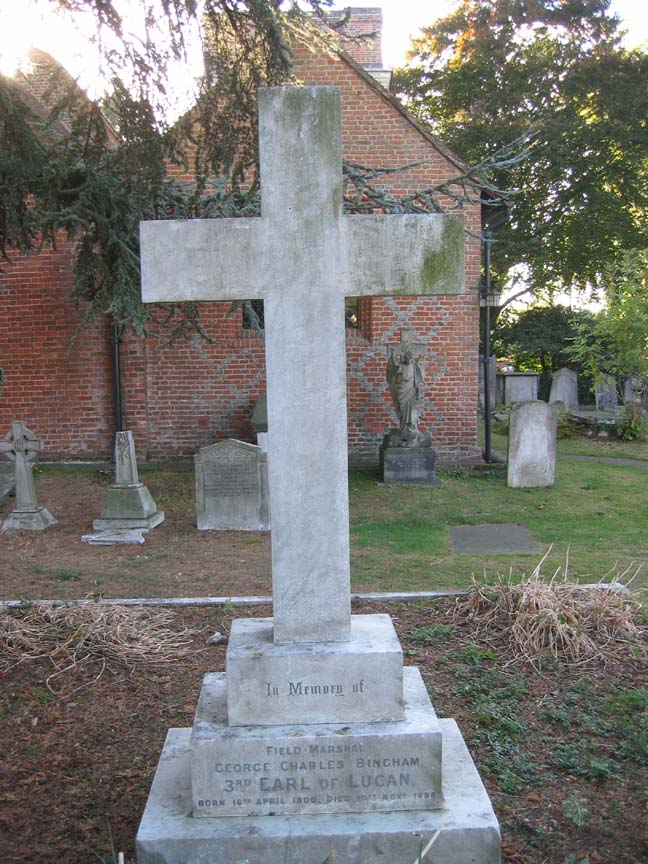
Birth: Apr. 16, 1800
Death: Nov. 10, 1888
British Army Officer. George Charles Bingham was born in London, the eldest son of the second Earl of Lucan and his wife, Lady Elizabeth Belasyse, the daughter of Earl Fauconberg, who had been married to and divorced from the Duke of Norfolk. Lord Bingham, as he was known until his father's death in 1839, was educated at Westminster School. When he was sixteen, a commision was bought for him in the 6th. Regiment of Foot. Within ten years, he had reached the rank of Lieutenant-Colonel in command of the 17th. Lancers. In the same year (1826), he was elected to the House of Commons, representing County Mayo in Ireland, where his family were landowners; he held this seat until 1830. In 1829, he married Anne, the youngest of the seven daughters of the sixth Earl of Cardigan. They were to have two sons and four daughters. Lucan became a Colonel in 1841 and a Major-General in 1851. In February 1854, when the British Army, under the command of Lord Raglan, was about to be sent to the Crimea, he was given command of the Cavalry Divison, which had two brigades: the Heavy Brigade under James Yorke Scarlett, and the Light Brigade under the seventh Earl of Cardigan, Lucan's brother-in-law, with whom he did not enjoy a good relationship. On the 25th. October, the Russians advanced on Balaclava and captured the redoubts, which had been held by Turkish troops. The Russians were then driven back by the Charge of the Heavy Brigade, after which Lucan placed the Heavy Brigade on the slopes. He was waiting for the approach of the Infantry, when Captain Nolan brought him the message: "Lord Raglan wishes the cavalry to advance rapidly to the front. Follow the enemy and try to prevent the enemy carrying away the guns. Troop of horse artillery may accompany. French cavalry is on your left. Immediate." The intention was for the attack to be on the Causeway Heights and the redoubts, but Lucan understood it, quite wrongly, to mean that the advance was to be along the North valley, at the end of which the defeated Russian cavalry was drawn up behind twelve guns, with other Russian troops on the heights at either side. Although he realised "the uselessness of such an attack, and the danger attending it", Lucan felt bound to obey, and sent the Light Brigade forward, with two regiments of the Heavy Brigade to cover its retirement. The Light Brigade was reduced from 673 to 195 men, the two Heavy regiments suffered, and Lucan was wounded in the leg. He was recalled and returned to England at the beginning of March 1855. He applied for a court-martial, which was refused, but was vindicated by the House of Lords. He had no further military employment, but was promoted to Lieutenant-General in 1858, General in 1865, and Field-Marshal in 1887. Also in 1858, he proposed the wording of the clause which enabled practising Jews, who could not take the Parliamentary Oath, to sit in the Houses of Parlaiment. In the 1968 film, "The Charge of the Light Brigade", Lord Lucan was played by Harry Andrews. The fourth and fifth Earls are buried on either side of him, along with their Countesses. The sixth Earl was a minister in the 1945-51 Labour Government, and the seventh Earl (b. 1934), who has not been seen since 1974, was found guilty in absentia of the murder of his children's nanny, Mrs. Sandra Rivett, and the attempted murder of his wife. (bio by: Iain MacFarlaine)
Burial:
All Saints Churchyard
Laleham
Surrey, England
http://www.findagrave.com/cgi-bin/fg.cgi?page=gr&GRid=90008360 -
Excellent stuff. I will see what I can think of!0
-
Eilís Dillon
Eilís Dillon (1920–1994) was an Irish author of 50 books, translated into 15 languages.
She was born in 1920 in Galway, Ireland. Her family was involved in Irish revolutionary politics; her uncle Joseph Mary Plunkett was a signatory of the 1916 Proclamation and was executed after the Easter Rising.
She started to produce children's books, in Irish, and later in English in the 1940s, including a string of successful teenage novels, some of which (The Lost Island, The Island of Horses) were still in print 50 years later.
In the 1960s she moved to Rome. Following her husband's death in 1970 she published her most successful historical novel, Across the Bitter Sea (1973), and in 1974 married the American-based critic and professor Vivian Mercier.
Eilís Dillon died in 1994 and is buried beside her second husband in Clara, Co. Offaly; a prize in her memory is given annually as part of the Bisto Book of the Year Awards.
Uploaded with ImageShack.us0 -
ahem JD
I thought the Earl of Lucan was buried in Huy, Belgium :D
:D
Patrick Sarsfield was the Jacobite Earl of Lucan0 -
Oscar Wilde is Jim Morrisons neighbour at Pere LaChaise in Paris.

Proust and Chopin are buried there too.The place is fairly huge with probably 100,000 plus graves and an estimated 1 milliom burials.So it is not exclusive.
Wildes funeral has been described as "cheap".
His wife Constance, had ownership of his works and refused to give him money as long as he saw Lord Alfred Douglas. The reason for this is likely to be to prevent a civil suit by his father the Marquess of Queensbury.
She refered to him as her "misguided husband" and they never divorced and predeceased him in 1898 and is buried in Genoa.0 -
-
If you thought Jack Lynch was the first Lynch from Cork to run a country -ahem you havent heard of this lady Elisa Lynch
Elisa Lynch (1835-1886) was the mistress of Francisco Lopez President of Paraguay,he was ousted and killed in a Civil War/ brazillian war along with her 15 year old son.
Dying in Paris in the 1990s Paraguay claimed her body and her tomb is her at the Recoleta cementery in Asuncion - Paraguay
http://www.irlandeses.org/dilab_lynchea.htm
Now the Lynch Clan includes Che GuervaraYou might think that even George Orwell would have no cause to fret about the World Cup reigniting tensions from a war that ended 140 years ago. Au contraire. If not for its winners, the War of the Triple Alliance remains a live issue for its losers. Indeed, as recently as last November, this newspaper carried reports of an event at which Paraguay’s vice-president called on Brazil to apologise for its brutality in 1870.
That call was made, curiously, at the launch of a book by an Irishman about an Irishwoman. The former was diplomat Michael Lillis, the latter Eliza Lynch: whose dramatic life has spawned several other accounts, including one by Anne Enright. Born in Cork, Lynch left Ireland in the fateful year of 1847 and, by extraordinary twists of fate, rose to wealth and fame as de facto “Queen of Paraguay”, until the aforementioned war set her on a reverse trajectory, back to poverty.
In her lifetime, she was regarded by Paraguayan critics as a mere prostitute who had seduced the country’s leader-in-waiting while he was living in Paris and then followed him home to become the unmarried mother of his six children. She was also blamed for provoking him into the disastrous war. But history has been rather kinder to her.
The Lillis book was unveiled in her former home in Asunción, where the regard for “La Lynch”, as she was once known, is such that she is commemorated both by the mausoleum to which her remains were eventually repatriated, and by the name of a major city avenue. Her posthumous popularity does not appear to be waning either. More than 1,000 packed the house for the book launch, with more standing outside.
There are fascinating parallels between Lynch and another Eliza – Gilbert – who was among her contemporaries. Gilbert became better known to the world as the “Spanish” dancer, Lola Montez, but she was born in Limerick (or possibly Sligo). She too was famously beautiful, and also charmed her way into high places – the affections of King Ludwig I of Bavaria in particular – and a low reputation; before, also like Lynch, coming to the sad end that 19th-century morality demanded.
It might be interesting too – in an entirely different way – to compare the Queen of Paraguay with another Lynch – Che Guevara – whose grandmother came from Galway. The influence of the extended Lynch family on Latin American politics is surely worth a PhD thesis, if one hasn’t been written already. In any case, Eliza Lynch is now a national heroine in her adopted country, where her last duties included burying her husband and a teenage son – both killed in the war’s decisive battle – with her own hands.
http://www.google.ie/#q=jack+lynch%27s+grave&hl=en&prmd=bo&ei=atExTMHLO5CQjAer1IHDBQ&start=10&sa=N&fp=d40c5b9049fc65b60 -
brianthebard wrote: »On the topic of politicians I wonder does anyone know where Willie Redmond was buried?I'm fairly sure he was killed during WWI.
Loker, Belgium. He died of wounds during the battle for Messines Ridge. Not my photo but here is the headstone. Redmond was originally buried in the grounds of a convent which is now gone. The CWGC wanted to move his body into the nearby Loker CWGC but the family refused permission so his grave now stands rather oddly in the middle of a field about 50 yards away from the cemetery. brianthebard wrote: »Thomas Kettle too.
brianthebard wrote: »Thomas Kettle too.
No known grave. Commemorated on the Thiepval Memorial.
http://www.cwgc.org/search/casualty_details.aspx?casualty=7981210 -
Advertisement
-
Judgement Day wrote: »....and the seventh Earl (b. 1934), who has not been seen since 1974, was found guilty in absentia of the murder of his children's nanny, Mrs. Sandra Rivett, and the attempted murder of his wife. (bio by: Iain MacFarlaine)
Hasn't his son been attempting to have his father declared dead and so inherit the title? There was an article in the papers many years ago about ground rents in Castlebar being owed to the estate.0 -
oncevotedff wrote: »Hasn't his son been attempting to have his father declared dead and so inherit the title? There was an article in the papers many years ago about ground rents in Castlebar being owed to the estate.
Yes it is ongoing as far as I know. After a regular spot on Spitting Image 'Lucky' Lord Lucan has disappeared without trace which is a bit of a pain for his heir but I'm sure all his tenants in Mayo are quite happy.
 0
0 -
Another famous seafaring man from the Sunny South East was Commodore John Barry (1745-1803) who is acknowledged as the founder of the US navy. There are statues to the Tacumshane man all over the place and his final resting place is in Saint Mary's Catholic Churchyard, Philadelphia

More info than you could possibly want here: http://en.wikipedia.org/wiki/John_Barry_(naval_officer)0 -
And one final one for tonight - a tale from the crypt. Bram Stoker (1847-1912), a black protestant wouldn't you know it and creator of Dracula. More info here: http://www.fairview-marino.com/bram-stoker


Bram Stoker's ashes along with those of his son repose in an urn at Golders Green Crematorium in London. I hope the lid is well fastened down! 0
0 -
I was literally about to post up that! Great minds eh!
 0
0 -
Thomas Kent (Ceannt), one of the leaders of the 1916 Rising and after whom Kent Railway Station in Cork is named, is buried in the grounds of Cork Prison and a memorial service is held there each year.0
-
Advertisement
-
Great thread folks. I laughed my arse off a few times at some of the comments. Keep it up.0
-
One last one before bed - William Joyce aka Lord Haw Haw - World War II comedian/voice of Germany?

Not so funny though if you were living in Britain during the war. I knew that he had been executed in England after the war but never realised that he had been brought back to Ireland. No pic of the grave in Galway yet but an interesting piece from the Connacht Tribune of Aug.20th 1976 here:
Galway Grave for Lord Haw Haw
Connacht Tribune, Friday, August 20, 1976.
The remains of Lord Haw Haw (William Joyce) will finally be laid to rest in Galway this afternoon, thirty years after he was hanged in London for treason. The reburial ends a ten—year campaign by Joyce's daughter, Mrs. Heather Iandolo, to have her father's remains brought to the city where he spent a large part of his childhood.
Galway Corporation yesterday confirmed that the reburial would take place at the New Cemetery in Bohermore at 2.30p.m. The complete funeral arrangements are being handled by an English firm of undertakers.
While it could not be confirmed yesterday what the traveling arrangements for the funeral party were, it seemed likely that the remains would be transported on the overnight car ferry from Holyhead, arriving in Dun Laoghaire at 6 a.m. The cortege was expected to set out by road for Galway this morning.
Mrs. Iandolo, a schoolteacher from Gillingham in Kent, has been campaigning since 1966 to have her father's remains removed to Galway. In that year she wrote to the then Mayor of Galway, Councillor Brendan Holland, enquiring about the possibility of going ahead with the reburial.
Councillor Holland thought the plan was acceptable and Mrs. Iandolo was given permission by the British Home Office in 1973 to have her father's remains exhumed from Wandsworth Prison in London. The Irish Government gave their consent in 1975.
Mrs. Iandolo then sought permission from Galway Corporation early this year and councillors readily acceded to her request.
A firm of undertakers in Middlesex began making arrangements for the transfer of the remains and through a local firm they arranged for the grave to be opened and a headstone to be erected.
The headstone, a white marble cross, will bear the inscription: "I am the resurrection and the life" — Dona eis Requiem — William Joyce, 23 April, 1906 — 3 January, 1946.
Family Background
Joyce was born in America in 1906. His father was Irish and his mother came from Yorkshire. The family came to Galway about 1920 and some time later the family moved to Britain. In 1924 a picture of Joyce was published in the Daily Sketch showing him with a razor slash on his check following a fracas involving Oswald Moseley's fascist marchers.
Joyce married in a London registry office at the age of 21 and later divorced his wife to marry Lancashire—born Margaret Carins White, whom he had met at a political rally.
They went to Germany and in September 1939 Joyce began his career on Radio Hamburg which was to earn him the nickname "Lord Haw Haw".
Joyce adopted a terribly British accent broadcasting Nazi propaganda and his chilling "Germany Calling, Germany Calling," introduction struck fear into homes all over Britain throughout the war.
Ironically, it was his distinctive voice which led to his capture after the war — Hilter's infamous propaganda minister Josef Goebbels made special arrangements for Joyce's escape, but Joyce got chatting to British officers in Denmark and his voice was recognized.
Brought back to Britain, he was placed on trial for treason (under the same 14th Century act which Roger Casement was tried) and sentenced to hang. He was hanged at Wandsworth Prison on January 3, 1946.0 -
Judgement Day wrote: »And one final one for tonight - a tale from the crypt. Bram Stoker (1847-1912), a black protestant wouldn't you know it and creator of Dracula. More info here: http://www.fairview-marino.com/bram-stoker
Bram Stoker's ashes along with those of his son repose in an urn at Golders Green Crematorium in London. I hope the lid is well fastened down!
Supposedly he or his ma spent time in Sligo at the time of the first cholera epidemic (1830-1832) and this was what gave him the inspiration for his book. Supposedly....0 -
I really am off to bed now but in a final search for a pic of Lord Haw Haw's grave I hit upon this gem - includes details of his bizarre capture, audio of a drunken last radio broadcast and details surrounding his trial and execution. Have a look you won't be disappointed.
http://www.nickelinthemachine.com/2010/02/the-execution-of-lord-haw-haw-at-wandsworth-prison-in-1946/0 -
Judgement Day wrote: »
Bram Stoker's ashes along with those of his son repose in an urn at Golders Green Crematorium in London. I hope the lid is well fastened down!
Now I am not saying Bram Stoker was supersticious but Cremation was unusual for peoople of his class so just maybe .......................
http://www.gods-and-monsters.com/how-to-kill-a-vampire.html
How to Kill a Vampire with Fire
At first, fire seems like an easy fix to your vampire problems, but there is a problem. Yes, it will burn vampires, just like it burns humans, but unlike sunlight and silver, it's only through natural means that a vampire will burn by fire. What I mean is, the reason sunlight and silver burn a vampire and cause its healing process to slow dramatically is because vampires are inherently cursed by these two elements. While fire can burn just as well as sunlight or silver, it does nothing to slow the healing process of the vampire, because vampires are not cursed with a weakness to fire.
If you're going to use fire to kill a vampire, you're going to need to have a big fire and have the vampire stuck in it for a long time. Probably, say, an hour to be safe, though about a half hour will usually do the trick. This is because the vampire heals as it burns. The hotter the fire, the faster it burns, but you're still basically trying to beat the speed of the vampire's healing process. Should the vampire be mostly burnt but then escape the fire, it can still survive.
It was not unusual for this time -Dr Sir Arthur Conan-Doyle wrote Sherlock Holmes.
Sir Arthur was hoaxed by two young girls with the fairy photos and alsi believed in spiritualism .
http://www.dailymail.co.uk/femail/article-1077709/Sherlock-Holmes-curious-case-garden-fairies.html0 -
Advertisement
-
Prince Michael Neale,(pronounced Nail) was Gazetted in Time Magazine on Sept 11 1944 as Prince Michael of the Saltees . Born in Ballymitty Co Wexford in 1911 he lived until 1998.Europe had a new royal house last week. In Dublin newspapers appeared a personal pronouncement: "I, Prince Michael Neale, landowner, will assume the title of Prince of the Saltees at the conclusion of the war. Also I wish it to be known that no one will be permitted to enter the Saltee Islands without a permit issued by me." Anybody caught interfering with the millions of birds or their eggs which inhabit those islands will be severely dealt with.
Prince Michael Neale is Eire's No. 1 manufacturer of cattle dip. As a County Wexford farmer's son, he used to lie on a cliff top in the long grass and gaze south across St. George's Channel to the tiny, haze-blue Saltee Islands. Since his first name was legally Prince, it was easy for a farm boy to daydream: "Some day I'll own those islands and become a real prince." He took to calling the Saltees "Paradise."
By last year he had sold enough dip to buy the Saltees. He began planting 3,000 trees, developing his domain as a luxury tourist resort. He also talked about recruiting a private army.
But last week Prince Neale had a right royal headache. To a reporter the Dublin prince-presumptive confided: "My wife, a Liverpool woman, is a bit shy about using the title of Princess. . . ." He added thoughtfully: "Anyone who does not call me Prince will be ignored
Read more: http://www.time.com/time/magazine/article/0,9171,775231,00.html#ixzz0stagexS5
He fought a long battle with the county council over rates, and refused to enter into correspondence with them until the addressed him as Prince.
He used to fly into Wexford in his private plane and give relatives kids plane rides during the harvest.
Was he a crank, I dont think so, he was a successful entrepeneur and owning the Islands was a boyhood dream.Unable to find any commercial exploitation for it he declared it a bird sanctuary.
I know he has a tomb somewhere and had a throne on the Island.
Where is he buried.0 -
Oscar Wilde is Jim Morrisons neighbour at Pere LaChaise in Paris.

Proust and Chopin are buried there too.The place is fairly huge with probably 100,000 plus graves and an estimated 1 milliom burials.So it is not exclusive.
Wildes funeral has been described as "cheap".
His wife Constance, had ownership of his works and refused to give him money as long as he saw Lord Alfred Douglas. The reason for this is likely to be to prevent a civil suit by his father the Marquess of Queensbury.
She refered to him as her "misguided husband" and they never divorced and predeceased him in 1898 and is buried in Genoa.
Oscar Wilde's life ended in great tragedy but his wife Constance remained true to him. She was forced to flee England with their two young children at his arrest and trial for "gross indecency" and the remainder of her life was lived under the name of Holland, which her children also took. Such was the "scandal" in English society of Wilde's trials that they had to flee and live anonymously and in greatly reduced financial circumstances. Considering what she had to endure she remained a decent wife to him and declined to divorce him when pressed by her family. During his prison term his mother died and it was Constance who - though ill - asked the prison authorities not to tell him and that she would come and break the news to him. She travelled from the Continent so as to be with him when she broke the news to him and console him in his grief. He later wrote about her gentleness and concern on this occasion.
Constance Wilde did not have control over any of Oscar's estate because there was none. Wilde was forced into bankruptcy during his time in prison - outrage on outrage Wilde had been taken from his prison cell in handcuffs and brought to the bankruptcy proceedings. He was penniless but his wife had some money that she had inherited in her own right. Through her own generosity she agreed to let him have part of this as income when he was released from gaol. There was a condition that he not see Alfred Douglas again but considering that Douglas was widely regarded as being largely responsible for sending Wlide to prison - and his father's actions had brought on the bankruptcy - this was not an unreasonable request. Many of Wilde's friends felt the same about Douglas. Robbie Ross was a more faithful friend and it was he who personally saw to it that Constance and the children were looked out for. After Wilde's death it was Ross who paid off Wilde's debts and purchased back many of Wilde's copyrights and gave them to Wilde's sons.
Constance died before her husband. He died in 1900. Due to a shortage of money - "I am dying as I have lived, beyond my means" - Wilde was first buried in Bagneux Cemetery - in a poor type of grave - and it was Robbie Ross who raised the money about 10 years later to have Wilde's body removed and then re-buried in Pere Lachaise.
I must say that the "misguided husband" quote has been taken completely out of context. It is from a letter that Constance wrote during the time she had decided not to divorce him and the sentence ends with her saying that she cannot refuse her husband the forgiveness that he asks of her.
I've done the pilgrimage to Pere Lachaise a few times. The inscription on the tomb is from The Ballad of Reading Gaol:
And alien tears will fill for him
Pity's long broken urn,
For his mourners will be outcast men
And outcasts always mourn.
Good old Oscar, he's a true hero - in the face of terrible odds he kept his own benevolent humanity and decency until the end. Robbie Ross's ashes are interred with him.0 -
Nice one MarchDub, Oscars Ma & Pa were famous in their own rights, where are they interred.0
-
Nice one MarchDub, Oscars Ma & Pa were famous in their own rights, where are they interred.
Oscar's father, Sir William Wilde is buried in Mount Jerome Cemetery, Dublin. Oscar's mother -Jane Wilde "Speranza" - is mentioned on the grave marker there but is actually buried in Kensal Green Cemetery, London. She died in London during her son's imprisonment and was refused her special request that he be allowed out of prison to visit her on her deathbed.
There are images of both graves online but alas, I am unable to embed them here. Just can't figure it - I'm not a tech person at all. Maybe you can do this?0 -
For those of you who don't know the story -his uncle described him as that "loathsome nephew" and he is William Patrick Hitler.
His mother Bridget was Irish and from Dublin and her surname was Dowling and she was married to Alois - Hitlers Older Brother.After the war they changed the family name to Stuart-Houston and lived in New York.
Pa was working as a waiter in the Shelbourne Hotel , Stephens Green Dublin and met Ma in the RDS.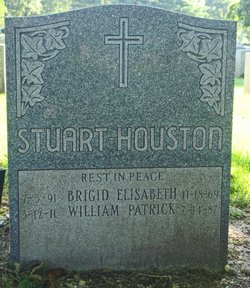
The graves are located at Holy Selpulchre Cemetary,Coram
Suffolk County
New York, USA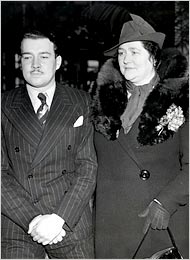
Willie had a much nicer moustache than his uncle and seems to have been an alright guy.
Ever on the scrounge for a few votes DeValera paid his respects at German Embassy after Adolfs death. Well, the Dowlings could always be counted on.
For more on the saga check it out here
http://www.independent.ie/national-news/irish-hitlers-372377.html
and
http://www.boards.ie/vbulletin/showthread.php?t=20555768300 -
Ever wonder what happened the Earls after the Flight of the Earls -well when I was 8 and in second class it really used to bother me because I knew that flying up to the 20 th century had been dangerous.
Well they reached Rome and survived the Flight and are buried here
[IMG]http://www.nuigalway.ie/archaeology/images/San Pietro facade 400 wide.jpg[/IMG]
http://www.irishtimes.com/focus/earls/main.htmlWhy it matters 400 years later
In the nave of the church of [PHP]San Pietro in Montorio[/PHP], not far from the Vatican, a black carpet covers much of the floor. Beneath it lie two elaborate marble tombstones, highly wrought with coloured inlay borders, shields, crests and Latin inscriptions extolling the Catholic faith, King Phillip III of Spain and Pope Paul V. The names on the stones are those of Hugh O'Neill, baron of Dungannon, son of the more famous Hugh O'Neill; Rory O'Donnell, Earl of Tyrconnell and heir to Red Hugh O'Donnell; and his brother Cathbharr. All three are recorded as having died of "fever" (probably malaria) in 1608 and 1609, less than two years after they, along with the cream of the Ulster Gaelic aristocracy, sailed from Rathmullan on Lough Swilly in what became known as the Flight of the Earls. Beside their graves is a stone marking the spot where Hugh O'Neill, the great Earl of Tyrone, is thought to be buried.
In this ancient city, so far from the woods and bogs where the Ulster earls inflicted terrifying defeats on the forces of a resurgent, self-confident Tudor England, these memorials mean little. The keepers of the church are not pleased by requests to roll back the carpet that covers them.
The stone that marks Tyrone's resting place is a modern copy, unveiled in 1989, of the original that was lost when the church was damaged in fighting between French forces and those of the Italian revolutionary Garibaldi in 1849. It was probably cut up and used for paving, the fate from which the other two memorials were narrowly rescued by the intervention of an Irish Dominican priest. These weird relics of an obscure, distant history scarcely matter to the Italians, and it is not at all obvious that they should matter to us.
[IMG]http://www.nuigalway.ie/archaeology/images/Drawing slabs 400 wide.jpg[/IMG]
The tombs have been excavated and you can read more here
http://www.nuigalway.ie/archaeology/Research/Gaelic_and_Colonial_Ireland/San_Pietro_in_Montorio/fitzpatrick_san_pietro.html0 -
Courtesy of Marchdub for reminding us of some forgotten giants.
Sir William Wildes grave
SIR WILLIAM WILDE, ONE OF IRELAND'S GREATEST EYE AND EAR SURGEONS AND FATHER OF OSCAR WILDE, ON EYESTRAIN AS A CAUSE OF VISUAL IMPAIRMENT
T. E. C. Jr MD
Sir William Wilde (1815-1876) is remembered today, if at all, as the father of Oscar Wilde. Largely forgotten is that he was not only a distinguished archeologist and statistician but also the dominant figure in otology and ophthalmology of the Dublin School of Medicine, which was at its peak during his lifetime.1
http://pediatrics.aappublications.org/cgi/content/abstract/68/5/664
Sir William Wildes grave in Mount Jerome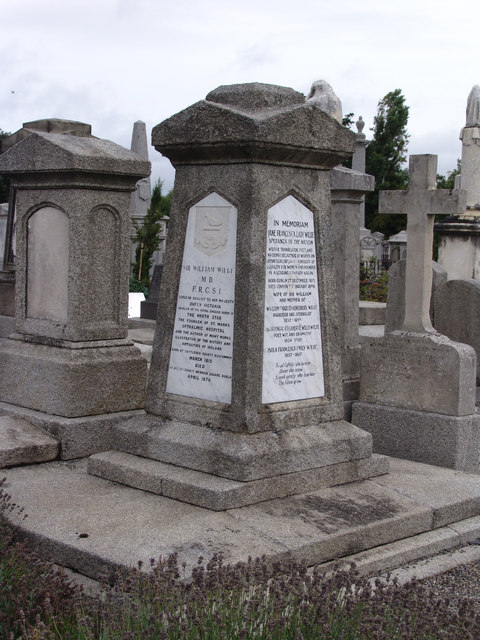
Oscar Wildes mothers grave
Jane Francesca "Speranza" Wilde
Original name: Jane Francesca Elgee
"Speranza" was her byline in "The Nation"
Birth: Dec. 27, 1821Death: Feb. 3, 1896
Lady Jane Francesca "Speranza" Wilde nee Elgee. She was a writer, translator, poet and nationalist. She was also a staunch fighter for equality for women and a writer of Irish folklore. She was also the mother of the famous poet, writer, dramatist and wit, Oscar Wilde. During his imprisonment, Oscar Wilde was refused permission to visit his mother's grave.
Burial:
Kensal Green Cemetery
Kensal Green
Greater London, England
Plot: She was buried in a paupers grave, which until recently was unmarked. Her new headstone is surrounde [unmarked]
Oscars parents lives were not without scandal and they were embroilled in a costly libel case which they lost over Sir Williams seduction/assault of a colleagues daughter which was brought by his(Oscars) mother after which Sir William semi retired. Bio and details hereand the allegation was not generally believed by his colleagues.He also fathered several children outside his marriage.
http://www.ncbi.nlm.nih.gov/pmc/articles/PMC1292568/pdf/jrsocmed00138-0063.pdf
The parallell with Oscars own case is striking. To quote Oscar
All women become like their mothers. That is their tragedy.
No man does. That's his.
EDIT - Sir William had 3 natural children Henry Wilson, and Emily and Mary Wilde who all died tragically and he provided for them. The girls died in a fire. Henry was a surgeon like his father and they worked together
http://www.springerlink.com/content/646223j7631ng432/
Emily & Mary died in a fire
http://www.jstor.org/pss/27699497
In the link above you will see that Henry left the bulk of his estate to St Marks Hospital. Roughly speaking it was £10,000 split 3 ways £8,000 to St Marks Hospital (Eye ear & throat) £2,000 to Willie (Oscars older brother) and £100 to Oscar. Oscar was flirting with Catholicism at the time and Henry disapproved of this.
It looks very much like Henry was Sir Williams child and his lifestyle was very different to that of his half brothers. Jane , Wildes mother, by comparison was buried in a paupers grave.0 -
While we are on the literary theme Mr Charlotte Bronte himself the Reverend Arthur Bell Nicholls is buried in Banagher Co Offally where he became a farmer after returning to Ireland following the death of Charlotte and her father.
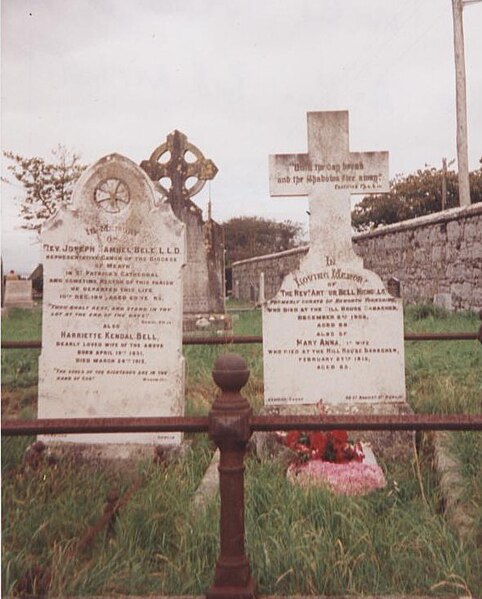
The Honeymooned in Offally (the mad things)
Five days later they travelled over from Holyhead to Dublin, enjoying a smooth passage and calm weather. However, at the prospect of meeting her new in-laws Charlotte was feeling quite nervous. In deference to her cold the couple travelled by railway to Birr and then by horse and carriage to Banagher. While on honeymoon she wrote in her journal what she thought of Cuba Court…….. "I cannot help feeling singulary interested in all about the house .In this house Mr. Nicholls was brought up by his uncle Dr.Bell. It is very large and looks extremely like a gentleman's country-house. Within, most of the rooms are lofty and spacious and some, the drawing room, dining room, etc.-handsomely and commodiously furnished. The passages look desolate and bare. Our bedroom, a great room on the ground-floor would have looked gloomy when we were shewn into it but for the turf-fire that was burning in the wide old chimney."
More here http://www.strynaghs.ie/charlotte_bronte.html
Charlotte was intered in Howarth Church in Yorkshire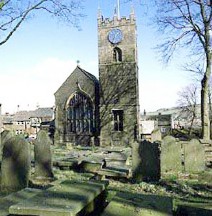

The shock for Charlotte was that she thought Arthur was a country bumpkin when the Nicholls family were at a level the Brontes probably aspired to.
Anyway,putting the chicklit days behind himArthur moved back to Ireland and married a nice Irish girl and was happy ever after.
*shudder I do not like the Bronte books- I hope it doesnt show*0 -
All these were near contemporaries of Mary Jane Kelly who became in 1888 the fifth and last known victim of "Jack the Ripper" .
She was originally from Limerick but grew up in Wales.
It is worth noting that not all who emigrated had nice lives.
An account of the funeral
THE FUNERAL OF MARY JANE KELLY
James Marsh
It was on Monday 19th November in 1888 that the mortal remains of Mary Jane Kelly, Jack the Ripper's fifth and final known victim were taken from the Shoreditch mortuary and interred at St Patrick's Catholic Cemetery in Leytonstone.
Since the horrifying facts of Mary Jane's death were revealed at the inquest, a great wave of sympathy for the unfortunate girl was felt in the area. No relatives came forward and Joseph Barnett, her one-time live-in lover, had not the means to meet the cost of her funeral. Thus it was that Mr H Wilson, the Sexton attached to St Leonard's Church, Shoreditch, put his sympathy into practical form and met the total cost of the funeral himself.
Mary Jane was laid into a polished oak and elm coffin with metal fittings. The following words were engraved on the brass coffin plate: 'Marie Jeanette Kelly, died 9th November 1888, aged 25 years'. Two wreaths of artificial flowers and a cross made up of heart seed were placed on the coffin, and it was put into an open hearse drawn by two horses and followed by two mourning carriages.
An enormous crowd had gathered outside the mortuary throughout the early hours of that morning, completely blocking the public thoroughfare, and a large number of police constables were placed there to keep order and protect property. The lone bell of St Leonard's began tolling at noon and this appeared to draw all the residents of the neighbourhood together, along with the already vast crowd waiting outside the mortuary.
There were many women in the crowd. Some drawn there by sadness and grief, and others by curiosity which related to the horror of the manner in which poor Mary Jane had died. The wreaths and cards on the coffin were Inscribed by many friends who had used the same public houses as the murdered girl.
When the coffin appeared at the main gates of St Leonard's, borne on the shoulders of four men, the waiting crowd became visibly distressed. Some of the men and women surged forward In an effort to touch the coffin as it passed. Women with tears streaming down their faces were screaming "God forgive her". and every man there removed his hat and stood with bared head In respect for this poor dead Irish girl. It was reported that the sight was quite remarkable and that the emotion shown by the crowd was natural and unconstrained.
Two mourning carriages followed the hearse. One containing Joseph Barnett, a female representative of his former Landlord, John McCarthy, and another woman. The other held five women, some of whom had given evidence at her inquest and were 'unfortunates', like Mary Jane. These mourners had prepared themselves for the ordeal by having a couple of drinks in a public house close to the gates of St Leonard's before the ritual began.
After a tremendous struggle with the crowds, the open hearse, with the coffin fully exposed to view, set off at a very slow pace and the whole crowd appeared to move simultaneously in attendance. The police constables on duty had great difficulty In obtaining free passage for the small procession through the mass of carts, vans and tramcars which had been brought to a standstill by the crowds.
The distance from St Leonard's to St Patrick's Catholic Cemetery in Leytonstone was approximately six miles. As the small funeral procession made It's way along Whitechapel Road the crowds on either side were described as 'very great'. In fact the scene was said to be remarkable due to the hundreds of men and women who escorted the coffin. This number rapidly thinned away when the procession reached the suburbs where the horses pulling the open hearse and following carriages broke into a steady trot.
Mary Jane's funeral procession arrived at St Patrick's at two o'clock. The body was met by Father Columban OSF (Order of St Francis), who was accompanied by two acolytes and a cross bearer, at the door to the little chapel of St Patrick, and the coffin was carried to an open grave in the north eastern corner listed as No 16, Row 67.
Joseph Barnett and the weeping women who had accompanied him as principal mourners knelt by the graveside while Father Columban read the service. There was still a large gathering of people outside the locked gates who were denied entry while the burial service was taking place. After the service, Barnett and the mourners visited' The Burbeck' public house which still stands close to the cemetery gates today
http://www.casebook.org/dissertations/rip-funeralmjk.html.
Archive Article from the London Times Here on the Whitechapel Murder
http://archive.timesonline.co.uk/tol/viewArticle.arc?articleId=ARCHIVE-The_Times-1888-11-10-07-011&pageId=ARCHIVE-The_Times-1888-11-10-070 -
One of Irelands most facinating actresses ever.
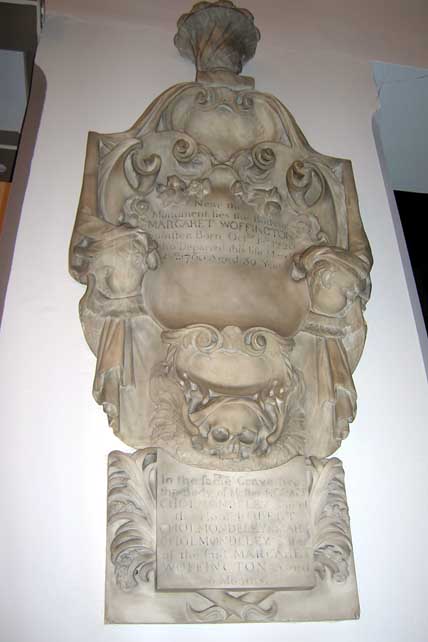 We also spent some time picking our way through autumnal leaves and cobwebs in the graveyard of Teddington's parish church, St Mary with St Alban, before realising that Woffington's memorial tablet (above) is actually inside the church, just within the north chancel arch. It describes her as a 'spinster, Born Oct. 18th 1720' and informs us that an infant nephew, 'Master Horace Cholmondeley, aged 6 months' lies in the same tomb.
We also spent some time picking our way through autumnal leaves and cobwebs in the graveyard of Teddington's parish church, St Mary with St Alban, before realising that Woffington's memorial tablet (above) is actually inside the church, just within the north chancel arch. It describes her as a 'spinster, Born Oct. 18th 1720' and informs us that an infant nephew, 'Master Horace Cholmondeley, aged 6 months' lies in the same tomb.
http://mrswoffington.blogspot.com/2009/10/in-search-of-mrs-woffington-part-1.html
My bit on Margaret Woffington
http://www.boards.ie/vbulletin/showpost.php?p=66871616&postcount=22
http://www.boards.ie/vbulletin/showpost.php?p=66879350&postcount=230 -
Advertisement
-
Napoleons Irish Doctors
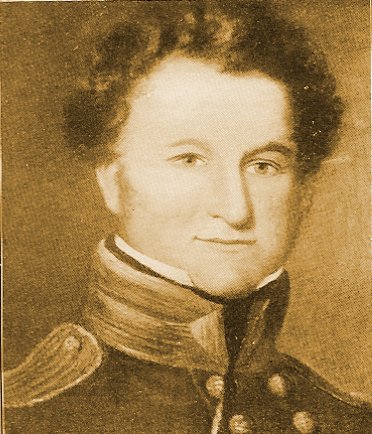
Napoleon and Dr. Verling on St. Helena
See what reviewers have said about this award-winning book!
Napoleonic scholar J. David Markham has again produced a book of singular importance to the understanding of the Napoleonic era. Few periods of Napoleon’s career capture the imagination more than that of his exile on the island of St Helena from 1815 to his death in 1821. Those years have provided more than their share of controversy, from the unfortunate treatment of Napoleon by the British governor, Sir Hudson Lowe, to the question of exactly how Napoleon died. Many of the people involved in Napoleon’s exile have published their memoirs or journals, and it seemed that there was nothing else left to learn. That is, until David Markham’s book, Napoleon and Dr Verling on St Helena arrived on the scene. Central to Napoleon’s six years on the island was the question of his medical care, and a succession of doctors was appointed to fulfill that role. The best doctor appointed to care for Napoleon was the Irish doctor, James Verling, on the island as medical officer to a British military unit. Verling, unlike other medical personnel on the island, actually had a medical degree and was clearly the best physician on the island. But the tension between Lowe and Napoleon was such that Napoleon would never accept a doctor appointed by his British jailor.
Even so, Dr. Verling treated members of Napoleon’s staff and was involved in the often petty and always fascinating events of the island. Verling kept a journal that until now had not been published in its entirety. Verling’s journal gives us a fresh and fascinating view of life in some of Napoleon’s last years. Verling never treated Napoleon. This was unfortunate for Napoleon, as a doctor of Verling’s ability might well have properly analyzed what was happening to destroy Napoleon’s health and taken steps to deal with the problem. It has now been scientifically proven by the most modern analysis conducted by Dr. Pascal Kintz, President of The International Association of Forensic Toxicologists, that Napoleon was poisoned. The scientific analysis of Napoleon's hair indicates that the source of the arsenic was mineral. This is the most toxic form of arsenic, and was used in France for many years as rat poison. These results were accomplished on the latest scientific analysis equipment that was just manufactured. This confirms all the previous testing made on Napoleon's hair on my behalf.
Verling would have been just the doctor to recognize the symptoms, make the proper diagnosis, and alert the British to the need to remove Napoleon from any possible source of poisoning. While this might not have led to his freedom, it might well have allowed him to die of old age after having dictated far more of his memoirs than he did.
http://www.napoleonichistory.com/napoleon_and_dr__verling_on_st__helena_57270.htm
http://en.wikipedia.org/wiki/James_Roche_Verling
He is buried in the Old Cemetary in Cobh.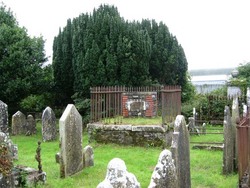
He was not Napoleons only Irish Doctor in captivity- he also had Dr Barry O'Meara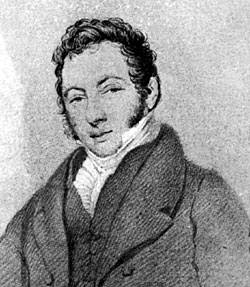
Barry Edward O'Meara (1786-1836) was an Irish surgeon and founding member of the Reform Club, who accompanied Napoleon to St. Helena and became his physician, having been surgeon on board the Bellerophon when the emperor surrendered himself. He is remembered as the author of Napoleon in Exile, or A Voice From St. Helena (1822) a book which charged Sir Hudson Lowe with mistreating the former emperor and created no small sensation on its appearance.
http://en.wikipedia.org/wiki/Barry_Edward_O'Meara
He is buried in a vault at St Mary's Church Paddington Green London. Napoleon liked him and encouraged him to keep a diary for publication after Napoleons death as a way to make money.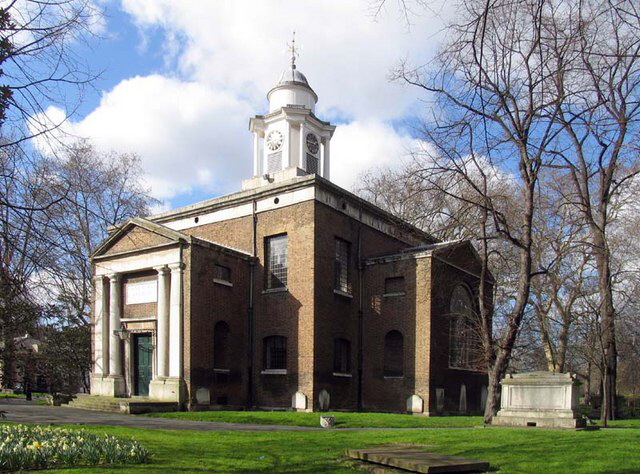
0 -

This Irish guy was irish and a movie director in Hollywood before Talkies until he just gone and got himself killed in real life.
http://query.nytimes.com/mem/archive-free/pdf?_r=1&res=980DE5D71130EE3ABC4D53DFB4668389639EDE Hollywood Forever
Hollywood Forever
Hollywood
Los Angeles County
California, USA
Plot: Cathedral Mausoluem, Crypt 594
</H2><H2 align=center>The Unsolved Murder of William Desmond Taylor William Desmond Taylor was a former actor turned director in early Hollywood. He was also one of the more colorful personalities of the time. But he is best remembered now for the manner of his death.
William Desmond Taylor was a former actor turned director in early Hollywood. He was also one of the more colorful personalities of the time. But he is best remembered now for the manner of his death.
Taylor, whose real name was William Cunningham Deane-Tanner, was born April 26, 1872 in Ireland. He came to the United States in 1890 and worked in a variety of jobs before finding work as a bit part player on the New York stage, under the name Cunningham Deane. After marrying the daughter of a wealthy Wall Street broker, Taylor, with financial assistance from his father-in-law, set up an antique furniture business. Now known as "Pete" Tanner, Taylor became a popular member of New York society. Then suddenly in 1908, Tanner disappeared, deserting his wife and a young daughter. It was during this time that he took the name of William Desmond Taylor.
He made his break into films in 1915, appearing in several forgettable silent films before making his directorial debut in 1914 with "The Awakening". He directed more than forty films over the next seven years, taking a break to serve as a Captain in the Canadian Army during the latter part of World War I. He also served as president of the Motion Picture Directors Association.
On February 2, 1922, Taylor's body was found in his Hollywood home, a bullet in his back. Neighbors reported hearing a gunshot during the night. During the inquest that followed several witnesses came forward, reporting that they had seen a young, dark-haired man leaving Taylor's house the night of February 1, and one of them not only saw the man, but heard the shot that killed Taylor immediately before seeing the man. Despite a long list of potential suspects, nobody was ever arrested or tried for the crime.
What was the motive behind Taylor's murder? One interesting theory that came out at the inquest involved the woman Taylor was seeing at the time of his death, actress Mabel Normand. She was a cocaine user, and Taylor had gone to the federal government for help in stopping the pushers who were selling her drugs. Seeing their business threatened, this scenario goes, the pushers decided to hire a hit man to "silence" Taylor. Taylor had been a prominent member of the Hollywood set, giving and attending parties where liquor was served (this was during Prohibition), so the press made much of his so-called wild personal life.
Coming as it did on the heels of the Fatty Arbuckle scandal and the drug-related death of actor Wallace Reid, Taylor's murder spurred Hollywood to clean up its act. Will Hays became president of the newly formed Motion Picture Producers and Directors Association, and a new age of censorship and studio control was born in Hollywood. As an unsolved crime, Taylor's murder has continued to intrigue and tantalize people. Over the years, conspiracy theorists have drawn up a long list of potential suspects - both individuals and groups that may have had a hand in the killing. Most seem fairly outrageous, but the continuing fascination illustrates our enduring fascination with both crime and Hollywood.
His killer confesses as per his Wiki entry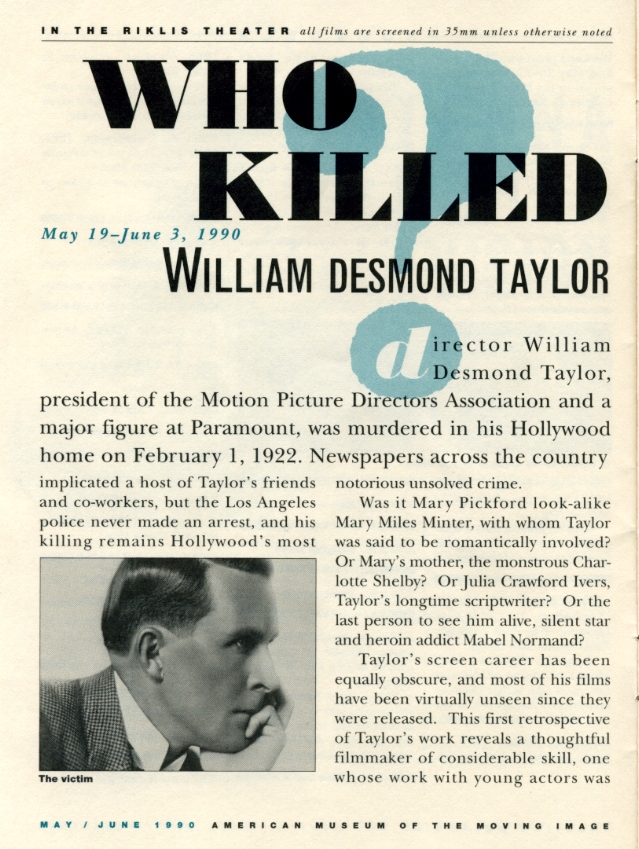
http://en.wikipedia.org/wiki/William_Desmond_TaylorMargaret Gibson's 1964 confession

Margaret Gibson
Margaret Gibson was a film actress who worked with Taylor when he first came to Hollywood. In 1917 she was indicted, tried and acquitted on charges equivalent to prostitution (there were also allegations of opium dealing) and changed her professional name to Patricia Palmer. In 1923 Gibson was arrested and jailed on extortion charges which were later dropped.
Gibson was 27 and in Los Angeles at the time of the murder. There is no record her name was ever mentioned in connection with the investigation. Soon after the murder she got work in a number of films produced by Famous Players-Lasky, Taylor's studio at the time of his death. One of these films was among the last made by Mary Miles Minter. Gibson (in her words) "fled" the United States to the Far East in 1934, where she married her husband who worked for Socony (later Mobil Oil). However, she returned to Los Angeles in 1940 for medical reasons. Her husband, Elbert Lewis, died in a March 1942 Japanese attack on the Socony oil refinery at Penang, Straits Settlements (now Malaysia) during World War II, leaving Gibson with a small pension.
In 1999 the widely cited newsletter Taylorology published an account that on October 21, 1964, while living in the Hollywood hills under the name Pat Lewis on her modest pension, she suffered a heart attack and as a recently converted Roman Catholic, before dying confessed she "shot and killed William Desmond Taylor" along with several other things the witness didn't understand and could not remember more than 30 years later.[21] The witness to her confession later repeated his recollection in a televised documentary.[22]0 -
Lady Hazel Lavery (1886 -1935) reputedly the lover of Michael Collins and society beauty.

She was described as a siren and a beautiful nuisance and married Sir John Lavery the artist 30 years her senior after they were both widowed.
Its impossible to say really if they were lovers given the circumstances and the Lavery's friendships with Winston Churchill and others andvthe Lavery's hosted the Irish delegation during the treaty negotiations. It probably is a myth -who knows.
So she is here for her face on the pound notes "porno for Paddies" and everyone loved her.
Her husband painted around 400 portraits of her.
Sir John 1856 -1941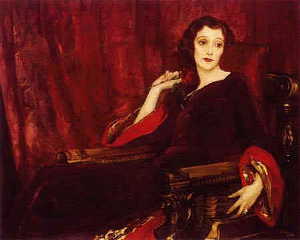
She is buried in Putney Vale Cemetary in London. She predeceased her husband Sir John by 6 years and he died in 1941.
Sir John born in Belfast om 1856 was an official war artist in WWI
http://www.art-ww1.com/gb/texte/096text.html
He also did a portrayal of Roger Casements trial
http://www.dublin.ie/calendar_details.aspx?eventid=23480 -
Samuel Beckett - Nobel Laureate, friend of James Joyce, sometime academic, existentualist, writer and author of Waiting for Godot.
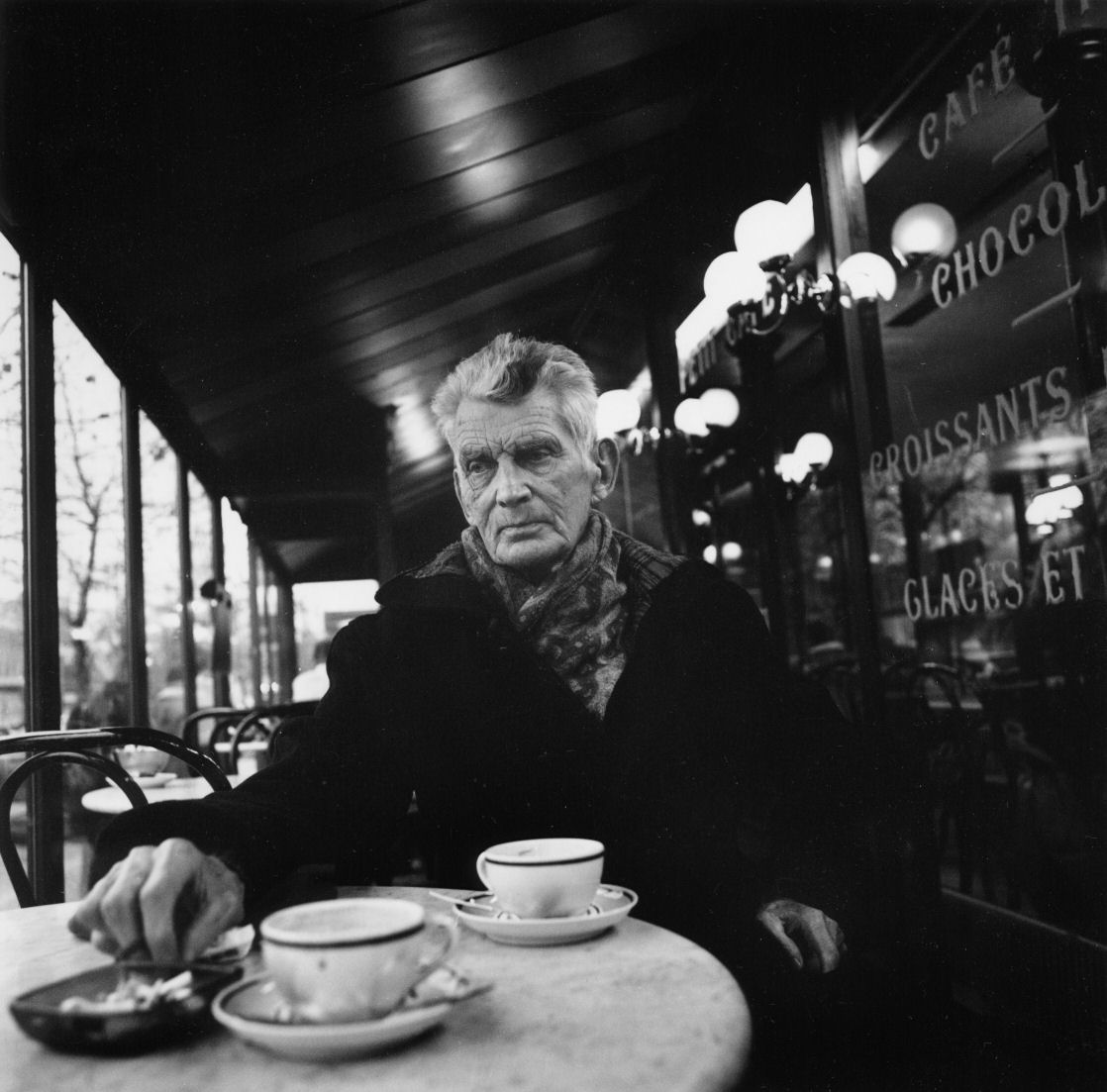
(Beckett was a recuring character in Sean Hughes stand up comedy shows in the early 90's and who never appeared but used to leave messages on the ansaphone when Hughes was depressed and shoegazing.)
Anyway here is a bio
[SIZE=+3]Samuel Beckett[/SIZE]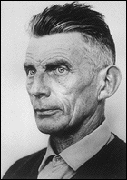 Samuel Beckett was born on Good Friday, April 13, 1906, near Dublin, Ireland. Raised in a middle class, Protestant home, the son of a quantity surveyor and a nurse, he was sent off at the age of 14 to attend the same school which Oscar Wilde had attended. Looking back on his childhood, he once remarked, "I had little talent for happiness."
Samuel Beckett was born on Good Friday, April 13, 1906, near Dublin, Ireland. Raised in a middle class, Protestant home, the son of a quantity surveyor and a nurse, he was sent off at the age of 14 to attend the same school which Oscar Wilde had attended. Looking back on his childhood, he once remarked, "I had little talent for happiness."
Beckett was consistent in his loneliness. The unhappy boy soon grew into an unhappy young man, often so depressed that he stayed in bed until mid afternoon. He was difficult to engage in any lengthy conversation--it took hours and lots of drinks to warm him up--but the women could not resist him. The lonely young poet, however, would not allow anyone to penetrate his solitude. He once remarked, after rejecting advances from James Joyce's daughter, that he was dead and had no feelings that were human.
In 1928, Samuel Beckett moved to Paris, and the city quickly won his heart. Shortly after he arrived, a mutual friend introduced him to James Joyce, and Beckett quickly became an apostle of the older writer. At the age of 23, he wrote an essay in defense of Joyce's magnum opus against the public's lazy demand for easy comprehensibility. A year later, he won his first literary prize--10 pounds for a poem entitled "Whoroscope" which dealt with the philosopher Descartes meditating on the subject of time and the transiency of life. After writing a study of Proust, however, Beckett came to the conclusion that habit and routine were the "cancer of time", so he gave up his post at Trinity College and set out on a nomadic journey across Europe.
Beckett made his way through Ireland, France, England, and Germany, all the while writing poems and stories and doing odd jobs to get by. In the course of his journies, he no doubt came into contact with many tramps and wanderers, and these aquaintances would later translate into some of his finest characters. Whenever he happened to pass through Paris, he would call on Joyce, and they would have long visits, although it was rumored that they mostly sit in silence, both suffused with sadness.
Beckett finally settled down in Paris in 1937. Shortly thereafter, he was stabbed in the street by a man who had approached him asking for money. He would learn later, in the hospital, that he had a perforated lung. After his recovery, he went to visit his assailant in prison. When asked why he had attacked Beckett, the prisoner replied "Je ne sais pas, Monsieur", a phrase hauntingly reminiscent of some of the lost and confused souls that would populate the writer's later works.
During World War II, Beckett stayed in Paris--even after it had become occupied by the Germans. He joined the underground movement and fought for the resistance until 1942 when several members of his group were arrested and he was forced to flee with his French-born wife to the unoccupied zone. In 1945, after it had been liberated from the Germans, he returned to Paris and began his most prolific period as a writer. In the five years that followed, he wrote Eleutheria, Waiting for Godot, Endgame, the novels Malloy, Malone Dies, The Unnamable, and Mercier et Camier, two books of short stories, and a book of criticism.
Samuel Beckett's first play, Eleutheria, mirrors his own search for freedom, revolving around a young man's efforts to cut himself loose from his family and social obligations. His first real triumph, however, came on January 5, 1953, when Waiting for Godot premiered at the Théâtre de Babylone. In spite of some expectations to the contrary, the strange little play in which "nothing happens" became an instant success, running for four hundred performances at the Théâtre de Babylone and enjoying the critical praise of dramatists as diverse as Tennessee Williams, Jean Anouilh, Thornton Wilder, and William Saroyan who remarked, "It will make it easier for me and everyone else to write freely in the theatre." Perhaps the most famous production of Waiting for Godot, however, took place in 1957 when a company of actors from the San Francisco Actor's Workshop presented the play at the San Quentin penitentiary for an audience of over fourteen hundred convicts. Surprisingly, the production was a great success. The prisoners understood as well as Vladimir and Estragon that life means waiting, killing time and clinging to the hope that relief may be just around the corner. If not today, then perhaps tomorrow.
Beckett secured his position as a master dramatist on April 3, 1957 when his second masterpiece, Endgame, premiered (in French) at the Royal Court Theatre in London. Although English was his native language, all of Beckett's major works were originally written in French--a curious phenomenon since Beckett's mother tongue was the accepted international language of the twentieth century. Apparently, however, he wanted the discipline and economy of expression that an acquired language would force upon on him.
Beckett's dramatic works do not rely on the traditional elements of drama. He trades in plot, characterization, and final solution, which had hitherto been the hallmarks of drama, for a series of concrete stage images. Language is useless, for he creates a mythical universe peopled by lonely creatures who struggle vainly to express the unexpressable. His characters exist in a terrible dreamlike vacuum, overcome by an overwhelming sense of bewilderment and grief, grotesquely attempting some form of communication, then crawling on, endlessly.
Beckett was the first of the absurdists to win international fame. His works have been translated into over twenty languages. In 1969 he was awarded the Nobel Prize for Literature. He continued to write until his death in 1989, but the task grew more and more difficult with each work until, in the end, he said that each word seemed to him "an unnecessary stain on silence and nothingness."
He is remembered chiefly for Waiting for Godot and was a modernist writer. He played with form and in Godot the characters have no future or past and are waiting for someone who does not appear. It is the foremost play of the Theatre of the Absurd.
Here is a review.
http://www.samuel-beckett.net/BerlinTraffic.html
Beckett objected to women acting in the the play when all womens groups began to stage the play in the 60's with the response "women dont have prostates" .
There is a lot of symbolism in Becketts work - bicycles represent hope and there are no bicycles in Godot. There is a carrot in Waiting for Godot and academics try to work out the significance of it.
http://www.samuel-beckett.net/JoysOfCycling.html
James Joyces daughter Lucia who was hospitalised for mental illness had a major crush on Beckett and when he didn't reciprocate precipitated a breakdown. So nowdays you will see that connection explored by academics and his own period undergoing therapy.
An intense and private man he met a french woman Suzzanne whom he was with for 50 years http://en.wikipedia.org/wiki/Suzanne_Dechevaux-Dumesnil
They died within months of each other in 1989 and are buried in Cimetière de Montparnasse Paris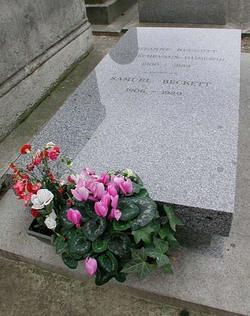
Now I am not a fan but he is a hugely significant writer and disloke his writing for the same reasons I dont like Joyce and Checkov for instance.
He was a fairly nice man though with a sense of humour that is not evident in his writing IMO.
On his grave when asked about a gravestone he said in parody of Henry Ford " any colour as long as its grey"
Any customer can have a car painted any colour that he wants so long as it is black.- Remark about the Model T in 1909, published in his autobiography My Life and Work (1922) Chapter IV, [p. 71-72]
0 -
Eamonn DeValeras mother Mrs Catherine Wheelwright ( Coll)
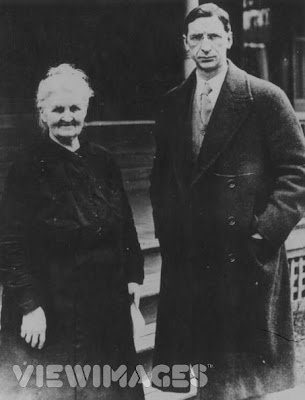
She died in 1932 and is buried in the Holy Sepulcher Cemetery. Rochester , New York with her husband Charles who died in 1929.
A nice bio is here and she had a son Thomas who became a priest.
http://en.academic.ru/dic.nsf/enwiki/1718444And Catherine de Valera Wheelwright, mother of Eamon de Valera, one of the leaders of the Easter Rising in 1916 and president of Ireland from 1959 to 1973.
http://findarticles.com/p/news-articles/buffalo-news/mi_8030/is_20100530/graves-famous-infamous/ai_n53843469/pg_2/?tag=content;col1
It is the same graveyard that the Bishops of Rochester are buried in and this is its website listing the notables buried there
http://www.holysepulchre.org/about/notable
But I also found this.About a mile further north is Holy Sepulcher Cemetery. Among the famous there are Louise Brooks, one of the great actresses of the silent film era. She was both a great sex symbol of the times and a highly praised actress. She had two husbands and dozens of lovers. She wrote that, among others, she had a one-night affair with Greta Garbo.
Long after her film career ended and she was living in near obscurity in New York City, she was rediscovered as the result to two film retrospectives in her honor, one in Paris, the other in Rochester. She moved to Rochester in 1956, living there for the rest of her life. She died in 1985 at age 78.
Also interred at Holy Sepulcher is Francis Tumuelty, who made a fortune selling fake medicines. He happened to be in London at the time of the Jack the Ripper murders (1888). He was arrested on a charge of homosexuality partly because somebody with the London police believed a homosexual was more likely to have committed the five (or 11, depending on who's counting) Ripper murders.
Tumuelty fled to France and then to the United States, where New York refused to extradite him because there was no hard evidence to connect him to the Jack the Ripper murders and because the crime he was charged with, homosexuality, was not an extraditable offense.
In 1913, Chief Inspector John Littlechild of the London police wrote a letter speculating Tumuelty was in fact Jack the Ripper, but Littlechild was never actually part of the team investigating the murders.
A historical oddity about Tumuelty is that two decades prior to the Jack the Ripper murders, he was briefly detained as a suspect in another famous murder case. In 1865, he was held for a while as a co-conspirator in the assassination of Abraham Lincoln. He was released when authorities realized they had mistaken him for someone else.
Also permanently residing at Holy Sepulcher is mystery writer Edward D. Hoch, who published more than 900 short stories, about half of them in Ellery Queen's Mystery Magazine.
Col. Patrick O'Rorke, who helped repel a Confederate assault on Little Round Top during the Battle of Gettysburg in 1863, is here. It helped assure the Union victory in the war's turning point engagement.
Well his Dad has never been conclusively located and young Ed was sent back home and became Eddie Coll.Here is a summary of the attempts to trace his father.
http://homepage.eircom.net/~seanjmurphy/irhismys/devalera.html
I am inclined towards the view that DeV's mother was economical with the truth. I see no reason for her to register the child as DeValera etc if it were not so.I also imagine there were other factors, other than being born outside marriage too that could have occured.
Whatever it was Catherine wasn't talking and outside our natural curiosity she was right. Worst case scenarios could also have been desertion, poverty, insanity, arrest or whatever.
A few years back I was looking for the records of a nun born in Ireland and became a nun here and who ended up teaching in New York State. Now you would say a nun and religious orders we could chase down a grave and details of the location of the Irish Convent & well I couldn't.
This extract from Time Magazine in 1932In Rochester, N. Y. a quiet old lady who dresses mostly in black was told that her son had become President. ''I am very happy to hear the news," said Mrs. Catherine Wheelwright. She bore Eamon de Valera where Manhattan's Chrysler Building stands today. The President's father (a Spaniard) is dead and so is his stepfather, Mr. Wheelwright. Several times Eamon de Valera has visited his old mother in Rochester.
Read more: http://www.time.com/time/magazine/article/0,9171,743383-2,00.html#ixzz0ujzgUYLb
And his half brother Fr Thomas Wheelwright
Well here is an account of a visit to Boston in 1919 where they met publicly
http://books.google.ie/books?id=euU4VBT29DgC&pg=PA270&lpg=PA270&dq=thomas+wheelwright+%2B+half+brother+%2B+eamon+de+valera&source=bl&ots=OjW4qEMlMV&sig=dq0L48U1OKvTrYgzcWzfbIdB7LI&hl=en&ei=ANlMTO36I6G80gSdkoCFCw&sa=X&oi=book_result&ct=result&resnum=3&ved=0CCwQ6AEwAjgK#v=onepage&q=thomas%20wheelwright%20%2B%20half%20brother%20%2B%20eamon%20de%20valera&f=false
</H1><H1 class=firstHeading>Thomas Joseph Wheelwright b. December 1890 d. 22 July 1946
Lineage Wheelwright Sex Male Full name (at birth) Thomas Joseph Wheelwright Parents ♂ # Charles E. Wheelwright URL="http://www.boards.ie/wk/Lineage:Wheelwright"][COLOR=#0000ff]Wheelwright[/COLOR][/URL b. 1857? d. 28 December 1927
♀ # Catherine T. Coll URL="http://www.boards.ie/wk/Lineage:Coll"][COLOR=#0000ff]Coll[/COLOR][/URL b. 23 December 1858 d. 12 June 1932
Reference numbers GEDCOM::510018.ged::INDI @I24893115@::Hailey C. Shannon Events
December 1890 birth: Manhatten
7 June 1916 ordination: Redemtorist Priest, Mt st Alphonsus, Esopus, NY
22 July 1946 death: Pennsylvania
Notes
According to US State Dept Archves, Father Wheelwright, CSSR, did much to help save his half-brother's life aftre the 1916 rebellion. Died in an automobile accident 1946 while taking another priest to the hosptial.
http://en.rodovid.org/wk/Person:746700 -
Richard "Dick" Monk Monaghon captain of the United Irish Insurgents in 1798 is buried in John St cemetary along with John Edward Redmond leader of the Irish Party at Westminster. Shame it's always locked up & impossible to see0
-
Strongbow -the Earl of Pembroke married King Dermots daughter. Meanwhile I had spent years thinking thay McMurrough was the only one to do deals with the Normans which is not true.
Strongbow is burried in Christchurch Dublin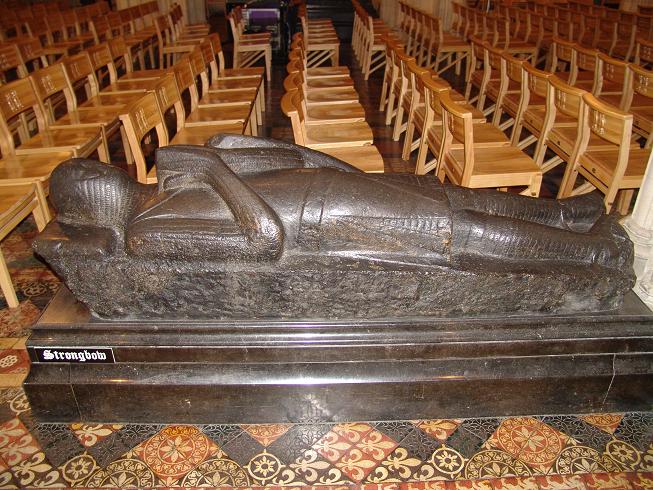
Anyway read who did what here.
Ousted King Dermot invited the Normans
By Peter Beresford
</I>In the late autumn of AD 1175 the scribe making an entry into the Annals of Clonmacnoise thought that he had good news to report to the people of Ireland.
“Cadhla Ó Dubhtaigh returned out of England from Henry FitzEmpress (Henry II), having obtained the peace of Ireland and the kingship of the same over both Foreigners and the Irish for Ruadrí Ó Conchobhair, and his kingdom and all provincial kings making tribute to Ruadrí as High King of Ireland.”
The scribe, who had taken over the task of keeping the annals up to date from Abbot Tighernach (c. 1020-1088), was either misinformed or was putting the best and most optimistic light on a bad situation.
It had been in 1169 when Norman adventures, at the invitation of the ousted King Dermot MacMorrough of Leinster, came to Ireland in order to put him back on the throne of his provincial kingdom.
Their leader, Richard FitzGilbert de Clare (nicknamed Strongbow) had married Dermot’s eldest daughter Aoife and thought this made him heir to Dermot’s kingdom. But the Irish law of succession did not allow for primogeniture. Kings had to be elected. Then in 1172 Henry II of the Angevin Empire came hot foot to Ireland in case Strongbow carved out an independent kingdom that might challenge his empire.
Although the High King, Ruadrí had managed to gain a few victories against the Normans, Ruadrí realised that he did not have the means to sustain a protracted campaign against the well-armed, centrally organised forces of the Normans. So he opened negotiations with Mylor FitzHenry, Henry II’s chief representative among the Normans in Ireland.
In 1175 Ruadrí appointed plenipotentiaries to go to meet Henry II who was ruler of the Angevin Empire with its capital at Anjou in Normandy. It is sometimes forgotten that England was then only a conquered province of that empire. Henry was neither born nor died in England and spent little time there. However, he agreed to meet the Irish negotiators at one of his castles in England — Windsor.
The Irish were led by Master Lawrence, described as the “Chancellor of the King of Connacht”. It is interesting that Lorcán, this was his Irish name, Chief Brehon to King Ruadrí, has been mistakenly identified as another Lorcán who also accompanied the Irish contingent. This other Lorcán was the Archbishop of Dublin (known today as St. Lawrence O’Toole). It is apparent in the text of the Treaty that they were two different people.
Archbishop Lawrence (c.1128-1180) was the son of The Ó Tuathail of Leinster. He signs the Treaty merely as a witness where it is clearly stated that he is “Archbishop”. The name of “Master Lawrence, Chancellor of the King of Connacht” appears as heading the negotiators at the top of the document.
His name appears with his fellow negotiators who are Cadhla Ó Dubhtaigh, the Archbishop of Tuam, and Cantordis, Abbot of Clonfert. Archbishop Cadhla is recognised as the senior ecclesiastic negotiator present who brings back “the peace” for Ireland.
Did the Treaty of Windsor, signed by the parties in the octaves of Michelmas (October 6) 1175, give peace to Ireland and recognise Ruadrí as remaining High King? The answer is no.
In fact, under the native Irish law system of the kingly successions, Ruadrí could not legally surrender his kingdom as High King. He had to abdicate his office and nowhere in the treaty is he referred to as High King. He is called King of Connacht, which royal line he came from before his appointment as High King. Ruadrí had been High King with much opposition among the other provincial kings.
The last native claimant of the High Kingship was from the Ulster kingdom, Brían Ó Néill. He became King of Ulster in 1241 and at a meeting of the Irish kings was elected High King of Ireland in 1258. He was killed in 1260 at the Battle of Downpatrick and his head was sent to London to be exhibited.
What the Treaty basically agreed was that the Ruadrí could remain as King of Connacht and King of any Irish territory over which he could exert authority that had not been conquered by the Normans. This was on condition that he pay feudal dues to Henry II who would now become Lord of Ireland and Ireland became part of the Angevin Empire.
Henry II, in his turn, had to pay feudal dues to the Pope who had encouraged and approved his conquest of Ireland. He had to pay a penny for every house in Ireland to the Papal coffers. This payment continued until May 15, 1213, when Pope Innocent III increased the annual tribute to 300 marks.
As for bringing peace in Ireland, more and more Norman adventurers arrived and began to carve out their own territories with sword and fire. The borders of the Irish provincial kingdoms were pressed back as the Kings fought to defend their territories. However, these Normans soon adopted the Irish language, Irish law and social customs.
Initially, the Irish people greeted The Treaty of 1175 with dismay and anger. Even in his own kingdom Ruadri found great opposition. He clung to power for 11 more years but, in 1186, was forced to abdicate as King of Connacht. He entered the monastery of Cong where he died in 1198.
One of his sons, Conor Moin, became King for three years and managed to inflict a major defeat on John de Courcy, the Angevin Viceroy. But in 1189 Conor was assassinated and after some period of instability, Ruadrí’s half-brother, Cathal Crobhderg (Cathal of the Wine Red Hand) was inaugurated as king at the traditional site of Carnfree. His reign was to last 23 years and he did much to stabilise the kingdom.
For almost 400 years, until 1541, the Irish kingdoms survived, if not with the same territories as they had in 1175 but with the same dynasties, laws and social structures. The Angevin Empire had vanished, England had asserted its independence and French was no longer the language of its ruling and middle classes.
Henry VIII not only broke with Rome but also announced that his title would be King of Ireland and no longer suzerain Lord of Ireland. He demanded the surrender of the titles and lands of the native Irish kings and their nobility. Should they surrender, they would be given English titles, agree to adopt the English language and English law.
The year 1541 saw the start of the real conquest of the Irish nation0 -
He was part of an infamous duo Burke and Hare from Ireland -who with his partner and the two mens wags killed 17 people. He gave his name toa killing method known as burking meaning getting someone drunk and smothering them. Hare his co-killer went Kings evidence and only Burke was convicted and the women also went free.
William Burkes skeleton may be seen at Edinburgh Anatomy Museum - Edinburg College of Medicine and Vetinary.The College of Surgeons have his deathmask, and several items like a wallet made from his skin.
Below is the College where his skeleton is located.
Burke & Hare the movie is out soon and is being advertised on TV :cool:
0 -
Good thread; it got me wondering where Ó Néill, Ruairí Ó Dónaill and those who led the Irish side in the Nine Years War are buried.
A quick google and they appear to be buried in the church of San Pietro in Montorio in Rome.
Aodh Rua Ó Dónaill, on the other hand, appears to have been buried in The Franciscan Monastery in Valladolid, Spain
This appears to be the Franciscan Monastery in Valladolid today. And here's the Spanish branch of the Ó Dónaill family outside Valladolid in 2002.
Valladolid is in north-central Spain, here.0 -
Advertisement
-
Good thread; it got me wondering where Ó Néill, Ruairí Ó Dónaill and those who led the Irish side in the Nine Years War are buried.
Thanks dionysis -any idea how they died and what they did when they got there.
These guys were skilled soldiers.
I often wonder whether like other nobles around Europe " they had issue" 0
0 -
This is a very interesting thread to read lads i must say0
-
Not Irish but we visited there and thought you might be interested. there's a real vibe at this grave. hard to explain.
 0
0 -
[FONT=Arial,Helvetica,Geneva,Sans-serif,sans-serif]Tomb of St Columbanus in Bobbio, Italy. He died in 615 AD. He was one of the greatest Irish missionaries of the period. He founded schools and monasteries all across Europe. Pilgrims still go to the tomb. [/FONT]
 0
0 -
Thanks dionysis -any idea how they died and what they did when they got there.
These guys were skilled soldiers.
I often wonder whether like other nobles around Europe " they had issue"
The Great Hugh O'Neill is buried in the church of San Pietro, Montoria, Rome. He died in Rome in 1616 apparently from an illness which caused a fever. Here are images of the church and the tombstone.
 0
0 -
hi all,first time posting in this section
i have one to add..its rory gallagher
he's buried in Saint Oliver's Cemetery, Model Farm Road, Cork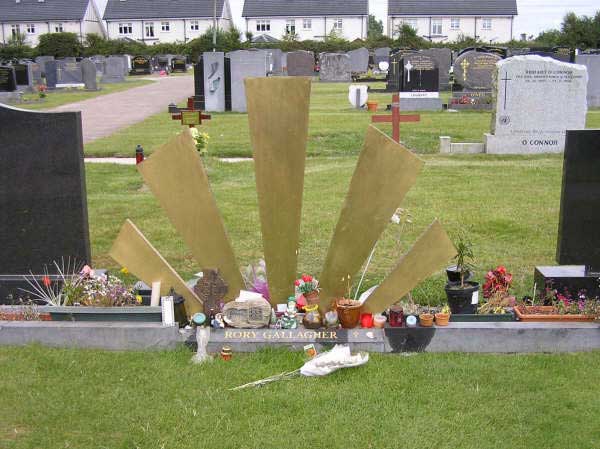
The design was modeled after an award that Rory achieved in 1972,
International Guitarist of The Year.
The award was about 10 in high and sat on a marble base...
The edge of one of the rays was made to be an exact replica of a Stratocaster neck.0 -
Advertisement
-
Both Wilde and Beckett have been done but I'll post two pictures I took in Paris a few weeks ago of their graves.

 0
0 -
LOL at the lipstick on the Wilde Monument.Becketts headstone is as stylish as the man himself and reflects him as Wilde's does him.0
-
I wonder about yerman who was found in the Bastille when the French revolutionaries stormed it? The mad Irishman?0
-
His name was james Whyte - Comte de Malleville and his story is here .
Following his release he was given a place to stay by some for the night -robbed it - and was locked up again in an asylum Charenton.
More here
http://www.irishmeninparis.org/framesets/jamesfxwhyte.htm
It would be interesting to know where he is buried.0 -
And there is more on the guyFriday, July 17. 2009
Bastille connection, by James O'Fee
Nicholas Whyte
Nicholas Whyte is an Ulster-born acquaintance with an amazing family connection with the Bastille. Once Nicholas asked to meet me in Belfast when I had been active in the postal Diplomacy hobby for some years and Nicholas was first becoming interested in the game of Diplomacy.
We're now back in touch through a social networking site and, through it, I have learned of the amazing Whyte family connection with the Bastille, the royal prison stormed by the Paris sans-culottes on 14th July 1798, an event commemorated by the French today as their most important national festival.
The claim to fame of Chevalier James F.X. Whyte (Dublin, 1730-Charenton, 179…), also known as Comte Whyte de Malleville, rests on his presence in the Bastille on the day the prison was stormed on July 14, 1789.
In fact, he was one of only seven (or six, it depends on who you read) prisoners that the Revolutionaries “liberated” from the Bastille that day, and one of two certified lunatics. Whyte’s perilous mental state did not stop his liberators from parading him through the streets and proclaiming him a hero of the revolution. According to Richard Hayes’ Biographical Dictionary of Irishmen in France, “an eyewitness of the day’s events describes him as ‘a little feeble old man who exhibited an appearance of childishness and fatuity, tottering as he walked and his countenance exhibiting little more than the smile of an idiot.’” Another witness described Whyte as having “a beard almost a yard long”, and as “wearing the smile of an idiot”.
Hero of the Revolution
When released, he is said to have declared himself “majeur de l’immensité”. A sympathetic citizen gave Whyte shelter for the night, but the Irishman pillaged the house of his benefactor. The following day, the hero of the Revolution was locked up again – this time in the lunatic asylum in Charenton, where he was to spend the rest of his days. Ironically, before the Revolution, Whyte’s family had tried to avoid having him placed in Charenton because of the harshness of the regime there. So much for ‘liberté, fraternité’ etc…But at least in Charenton, he would have hooked up with his acquaintance, the Marquis Sade, who had been shipped to Charenton from the Bastille on July 4, 1789.
Whyte had followed a military career in France after leaving Ireland and rose to the grade of captain in Lally’s regiment of the Irish Brigade. He suffered a mental breakdown in 1781 and was confined in a hospital in Vincennes and then to the Bastille three years later (along with the Marquis de Sade) when the institution in Vincennes was closed. In March 1789, he was deprived of his civil rights and his property was transferred to his daughters.
See Irishmen in Paris.
Nicholas adds -
I suspect that he [Chevalier James F.X. Whyte:Ed] was a grandson of Charles Whyte who was Jacobite MP for Naas and governor of Kildare in the 1689-92 war. Though there were other continental family connections - James II's ambassador in the Hague was Sir Ignatius Whyte, another cousin (and yet the Dutch invaded).
http://www.impalapublications.com/blog/index.php?/archives/3884-Bastille-connection,-by-James-OFee.html0 -
Advertisement
Advertisement



 https://www.youtube.com/watch?v=UE7KvAyVnbw
https://www.youtube.com/watch?v=UE7KvAyVnbw